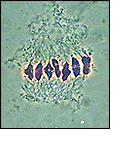|
 Previous Event | Next Event Previous Event | Next Event 
1902: Chromosome Theory of Heredity
 Walter Sutton, a graduate student in E. B. Wilson’s lab at Columbia University, observed that in the process of cell division, called meiosis, that produces sperm and egg cells, each sperm or egg receives only one chromosome of each type. (In other parts of the body, cells have two chromosomes of each type, one inherited from each parent.) The segregation pattern of chromosomes during meiosis matched the segregation patterns of Mendel’s genes. Walter Sutton, a graduate student in E. B. Wilson’s lab at Columbia University, observed that in the process of cell division, called meiosis, that produces sperm and egg cells, each sperm or egg receives only one chromosome of each type. (In other parts of the body, cells have two chromosomes of each type, one inherited from each parent.) The segregation pattern of chromosomes during meiosis matched the segregation patterns of Mendel’s genes.
Sutton had been observing grasshopper cells, where chromosomes have quite distinct shapes. He published his findings in 1902 and a year later, made an even stronger argument to connect Mendel’s laws of heredity and the behavior of chromosomes in his paper The Chromosomes in Heredity.
In many ways, Sutton reiterated the work of Theodor Boveri, a German scientist who in the late 1880s and early 1890s observed that chromosome numbers are cut in half as egg cells mature, and concluded that sperm and egg nuclei have half sets of chromosomes.
More Information
Diagram Showing Meiosis 
To view this PDF, you will need Adobe Reader. 
References
Sutton, Walter, "The Chromosomes in Heredity", Biological Bulletin 4 (1903): 231-251.
L.C. Dunn said this paper marked the "beginning of cytogenics". Sutton suggests for the first time in a concrete way that hereditary anlagen (genes, after 1909) lay on the chromosomes, and that this gives a cytological explanation to Mendel's principles.
 Previous Event | Next Event Previous Event | Next Event 
Last Reviewed: April 17, 2008
|

